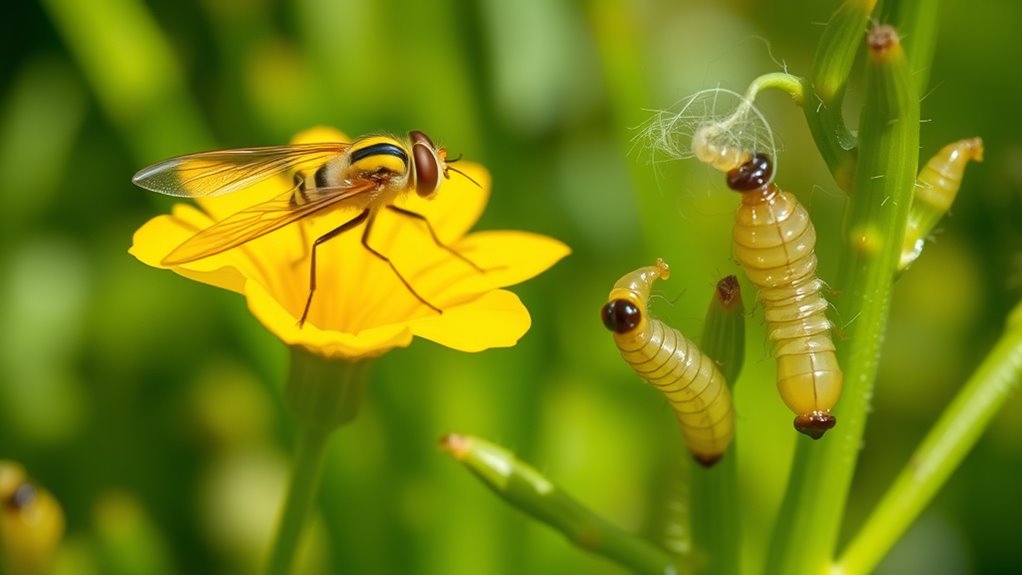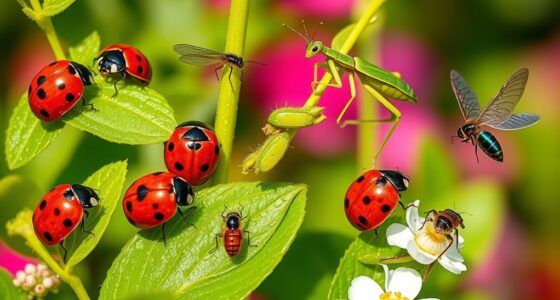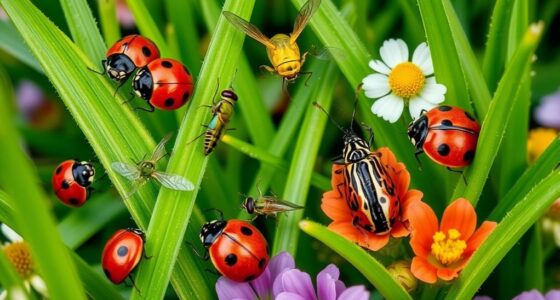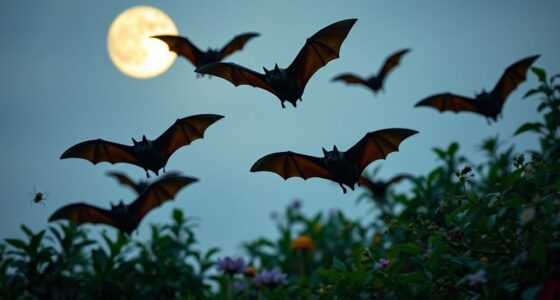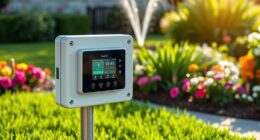To identify hoverfly larvae and adults, look for small, worm-like larvae in plant galls, water, or soil—they’re usually 1-2 mm long and soft-bodied. Adult hoverflies are larger, with brightly colored bodies, distinctive markings, and rapid, darting flight patterns. Adults often mimic bees or wasps and have short antennae, while larvae are simple and elongated. Spotting these features helps distinguish between the stages; explore further to discover more identification tips.
Key Takeaways
- Adult hoverflies are characterized by vibrant colors, distinctive markings, and clear, rapidly beating wings for smooth flight.
- Larvae are small (1-2 mm), worm-like with soft, segmented bodies, developing in habitats like leaf litter, soil, or aquatic environments.
- Adults often mimic bees or wasps through bright color patterns and markings, aiding in predator deterrence.
- Movement patterns differ: adults hover, dart, and migrate seasonally; larvae are slow-moving or stationary within their habitats.
- Identification relies on physical features such as wing markings, body shape, size, and behavior observed in their respective life stages.
Physical Characteristics of Hoverfly Adults

Hoverflies, also known as flower flies or syrphid flies, are easily recognizable by their vibrant coloration and distinctive markings. Their wing structure is remarkable—you’ll notice that their wings are clear, with a rapid, steady beat that allows smooth flight. Hoverflies have two wings, unlike bees or wasps, and their wing muscles enable quick, agile movements. Their antenna length varies but is typically short relative to their head, giving them excellent sensory awareness. These antennae help them detect scents and navigate their environment efficiently. The combination of their wing structure and antenna design allows hoverflies to hover precisely over flowers, making them effective pollinators. Their ability to mimic bees or wasps can also serve as an offensive defense mechanism against predators. Observing these features helps you distinguish adult hoverflies from other insects with similar appearances.
Key Features of Hoverfly Larvae
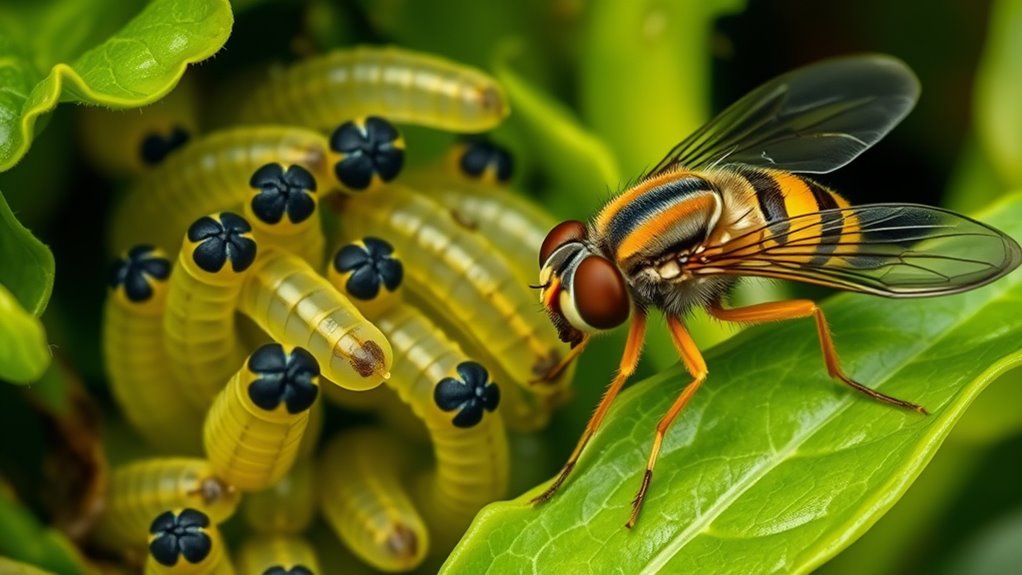
Hoverfly larvae differ markedly from their adult counterparts in appearance and behavior. They are often worm-like, with soft, segmented bodies that lack wings. You’ll notice their varied feeding habits: some larvae feed on aphids, making them beneficial for pest control, while others consume decaying organic matter or plant material. Their larval habitat preferences are diverse; many thrive in moist environments like leaf litter, rotting wood, or soil rich in organic debris. Some species develop inside plant galls or aquatic habitats. These adaptations help larvae access their food sources efficiently. Understanding these key features can help you identify hoverfly larvae in different environments, especially by observing their feeding habits and preferred habitats. This knowledge is essential for recognizing their role in ecosystems and can also indicate the presence of other insects based on their environmental preferences.
Size and Shape Differences Between Stages
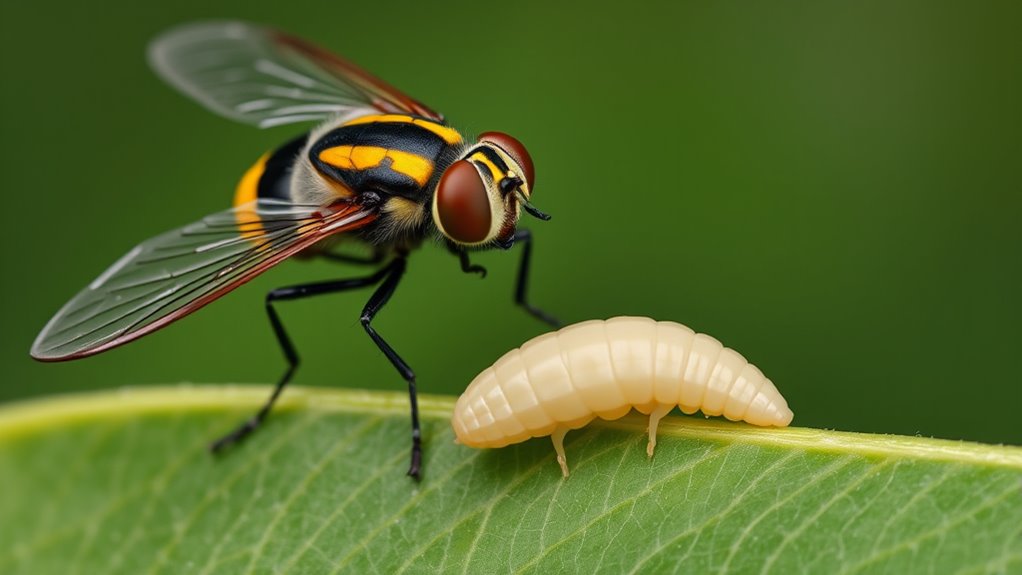
While the larvae and adult hoverflies serve different roles in their lifecycle, they also show striking differences in size and shape. You’ll notice that larvae are typically elongated, worm-like, and small, while adults are more compact with distinct wing and body structures. This shape variation reflects their functions at each stage. For a clear size comparison, consider this:
| Stage | Size | Shape |
|---|---|---|
| Larvae | Small, 1-2 mm | Slender, worm-like |
| Adults | Larger, 8-15 mm | Compact, winged |
This contrast helps you quickly identify each stage. The shape variation emphasizes the larval’s simple form versus the adult’s more developed, winged body. Recognizing these differences is key to understanding hoverfly development. Developmental stages play a crucial role in their lifecycle, highlighting the importance of size and shape differences at each phase.
Coloration and Markings to Recognize
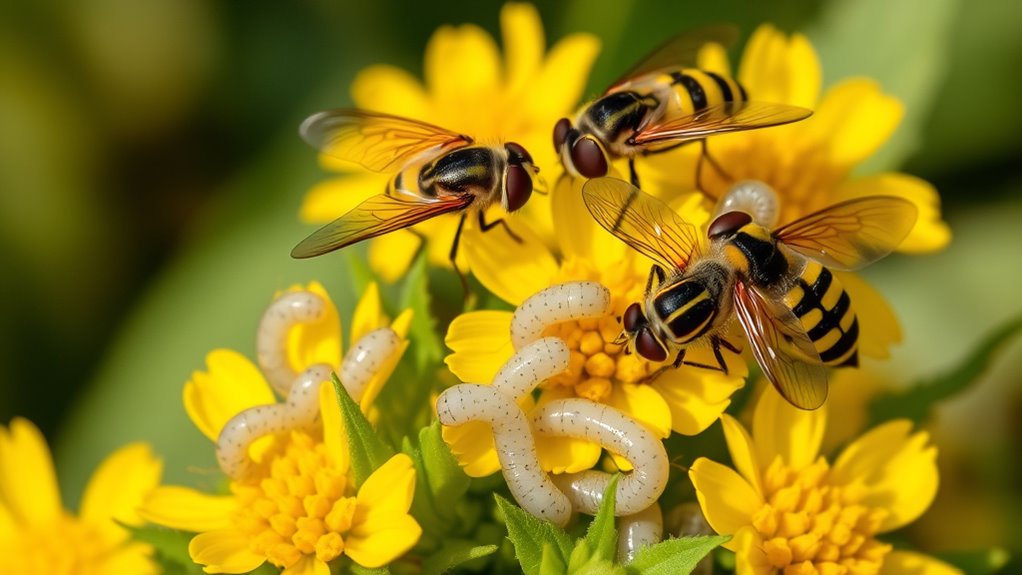
You can often identify hoverflies by their bright color patterns and distinctive markings. These visual cues help you distinguish them from bees or wasps. Pay attention to the differences in markings to accurately recognize different hoverfly species. Recognizing insect identification features can further aid in distinguishing hoverflies from other insects.
Bright Color Patterns
Bright color patterns are one of the most striking features that help identify hoverflies. Many species use flower mimicry, displaying bright yellows, oranges, and blacks that resemble real flowers. This adaptation attracts pollinators and confuses predators. Some hoverflies also exhibit warning coloration, signaling that they might be distasteful or toxic, even if they aren’t. These bold patterns serve as visual cues, helping you distinguish them from other insects. Pay attention to their vibrant stripes or spots, which are often contrasting and highly visible. Recognizing these bright color patterns enables you to identify hoverflies quickly and appreciate their role in pollination. Their eye-catching appearances are both functional and beautiful, making them easy to spot once you know what to look for. Additionally, understanding their mimicry strategies can provide deeper insight into how hoverflies have evolved to survive in their environments.
Distinctive Markings Difference
Hoverflies can be distinguished from other insects by their unique markings and coloration, which go beyond just bright color patterns. You’ll notice their larvae often use camouflage, blending seamlessly into leaves or bark to hide from predators. Adults, on the other hand, mimic bees or wasps with bold stripes and contrasting colors, providing a false sense of threat. These markings are key to identification: Hydrocolloid technology promotes healing by drawing out impurities, making it easier to spot and treat their blemishes. Recognition tips include observing behavior and habitat; look for movement patterns and markings to identify them accurately.
Behavior and Movement Patterns

Hoverflies exhibit remarkable agility and diverse movement patterns that help them efficiently locate food and evade predators. They often display rapid, darting flights, making it difficult for predators to catch them. During foraging activity, you’ll notice hoverflies repeatedly hover, pause, and then dart toward flowers or foliage, maximizing nectar and pollen intake. Some species show migratory behavior, traveling long distances to find ideal breeding or feeding sites, especially in response to seasonal changes. Their movement is highly adaptable; they can switch from local foraging to longer migrations, depending on environmental cues. This combination of swift, unpredictable flights and seasonal movements enhances their survival and reproductive success, allowing them to thrive across various habitats and conditions. Additionally, their ability to adapt their movement patterns based on local environments contributes significantly to their resilience and widespread presence.
Habitats and Typical Environments

Hoverflies can be found in a variety of environments, from open fields to bustling urban areas. You’ll notice them hovering around flowers, crops, and even in parks or gardens. Understanding their habitat preferences helps you recognize where they’re most likely to thrive. Creating habitats for pollinators such as planting native species and providing shelter can further support hoverfly populations.
Habitat Preferences in Fields
In fields, hoverflies are often found flitting among flowers and foliage, where they seek nectar and pollen. These habitats support their role as pollinators, benefiting crop production. However, pesticide impact can threaten their populations, reducing pollination efficiency and disrupting ecosystems. You’ll notice that hoverflies prefer diverse plantings, which provide both food and shelter. They thrive in areas with minimal chemical use, where they can complete their larval stages and hunt aphids. Fields with a variety of flowering plants attract more hoverflies, boosting natural pest control and crop pollination. By understanding their habitat preferences, you can create an environment that supports healthy hoverfly populations, ultimately improving crop yields and maintaining ecological balance. Additionally, designing fields that incorporate pollinator-friendly practices can further enhance hoverfly survival and effectiveness.
Urban and Natural Areas
Urban and natural areas offer diverse habitats where hoverflies can thrive beyond traditional fields. In cities, you’ll find them around gardens, parks, and roadside vegetation, where nectar sources like flowering plants attract them. These environments provide ample food and shelter, helping hoverflies avoid predators. Natural areas such as woodlands and meadows also support hoverfly populations by offering abundant nectar sources and hiding spots from birds and other predators. Urban settings often have fewer large predators, giving hoverflies a better chance to feed and reproduce. You’ll notice them hovering near flowers or resting on leaves, taking advantage of these rich habitats. Moreover, the presence of vetted camping gear in these areas can enhance outdoor experiences for enthusiasts observing or studying hoverflies. Overall, urban and natural spaces expand the range of environments suitable for hoverflies to feed, reproduce, and avoid threats effectively.
Tips for Observing and Differentiating Stages

To accurately observe and differentiate the various stages of hoverflies, focus on key physical features and behavioral cues at each phase. In larvae, look for small, worm-like bodies often found on plants or in water, indicating their pest control benefits by preying on pest insects. Adults are more noticeable: they have distinct patterned wings, large compound eyes, and a hovering flight pattern. To identify and distinguish stages, consider these tips:
Observe hoverfly larvae’s worm-like bodies and adults’ patterned wings and hovering flight to identify stages.
- Observe larval movement and habitat, noting their role in pollination roles indirectly by controlling pests.
- Notice adult wing markings and body shape, essential for species identification.
- Watch flight behavior—larvae are stationary or slow-moving, while adults hover and dart around flowers.
These cues help you track their development and appreciate their ecological importance.
Frequently Asked Questions
How Can I Distinguish Hoverflies From Bees or Wasps?
To distinguish hoverflies from bees or wasps, focus on visual identification and behavioral differences. Hoverflies often have a more streamlined body with less hair and mimic bee or wasp coloration, but they lack the stinging ability. They hover actively around flowers, unlike bees and wasps that tend to land more often. Watch their flight patterns—hoverflies stay in place or move smoothly, while wasps and bees fly more directly.
Are Hoverfly Larvae Harmful to Plants or Humans?
Imagine this: curious creatures crawling close to your plants. Hoverfly larvae are harmless helpers rather than harmful hazards. They actually promote plant safety by eating pests, and they pose no threat to human health. You can confidently welcome these beneficial bugs into your garden, knowing they’re friendly and focused on fostering healthy plants. Rest assured, hoverfly larvae don’t harm your plants or people—they’re nature’s helpful allies.
When Is the Best Time of Year to Observe Hoverfly Larval Stages?
You can observe hoverfly larval stages during their peak seasonal activity in spring and summer. These are the best times for larval sightings since larvae are actively feeding and developing. Warm weather encourages their emergence, so keep an eye out from late April to early September. By spotting larvae during these months, you’ll better understand their role in the ecosystem and their seasonal behavior.
Do All Hoverfly Species Have Similar Larval and Adult Features?
You’ll find that not all hoverfly species share similar features, as there are significant morphological variations and species-specific traits. Adults often differ in coloration, wing patterns, and body shape, while larvae vary in size, shape, and habitat preferences. These differences help you identify each species more accurately. Recognizing these unique traits allows you to understand their roles in ecosystems and their adaptations to diverse environments.
Can Hoverfly Larvae Be Found Indoors or Only Outdoors?
Ever wonder if hoverfly larvae venture indoors or stay outdoors? You might be surprised to learn that indoor sightings are possible, especially when they find cozy larval habitats in places like potted plants, compost bins, or damp areas. While they mainly thrive outside, some larvae can be found inside homes, often hitching a ride on plants or in moist environments. Keep an eye out—these tiny visitors can surprise you!
Conclusion
Once you can spot both hoverfly larvae and adults, it’s like reading a fascinating story in nature’s own book. I once watched a tiny larva inching along a leaf, then later saw the sleek adult darting through a garden. Just as a book’s chapters reveal different tales, each stage offers unique beauty and clues. With a little practice, you’ll be able to recognize these incredible transformations and appreciate the magic behind every hoverfly.
